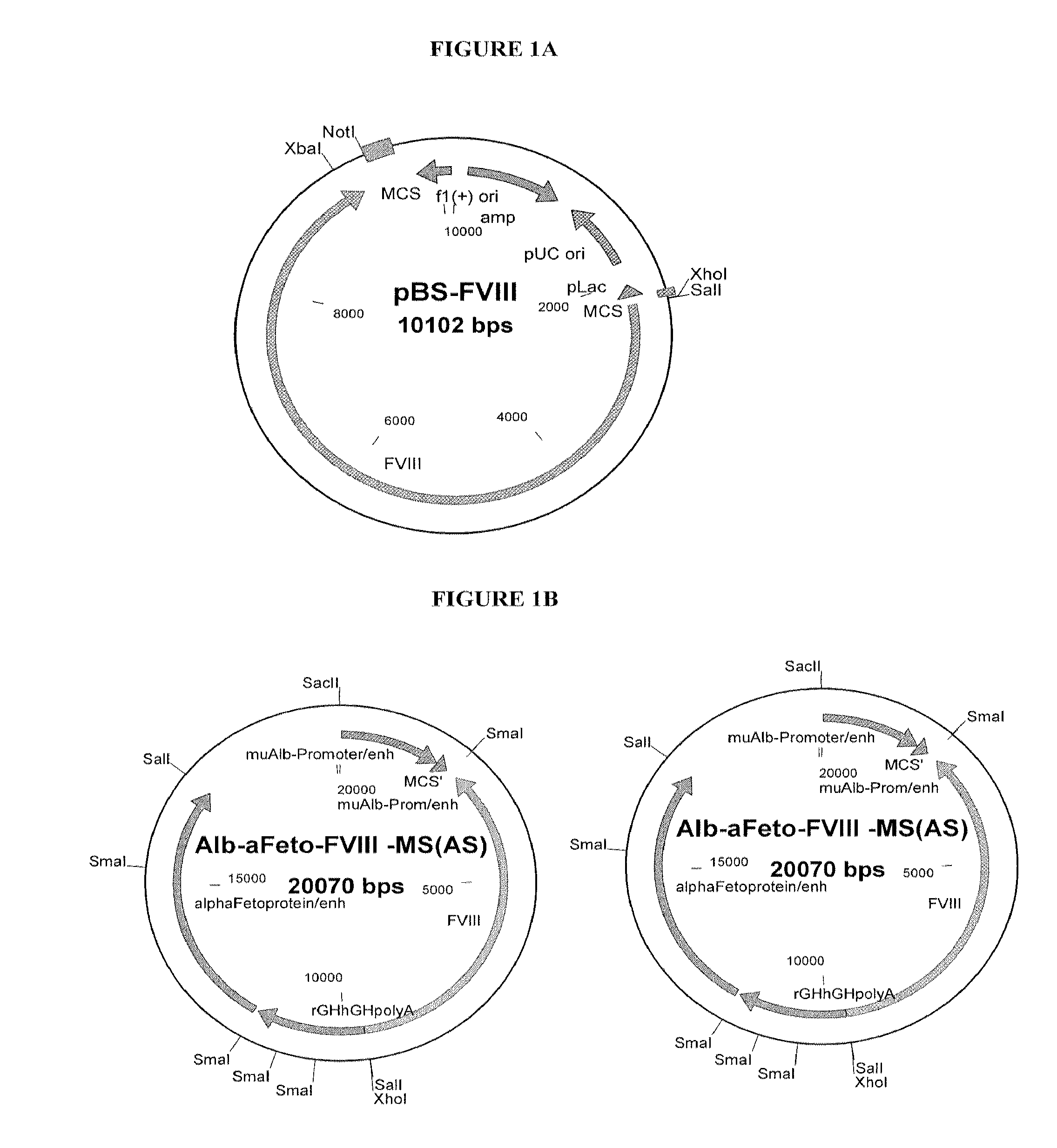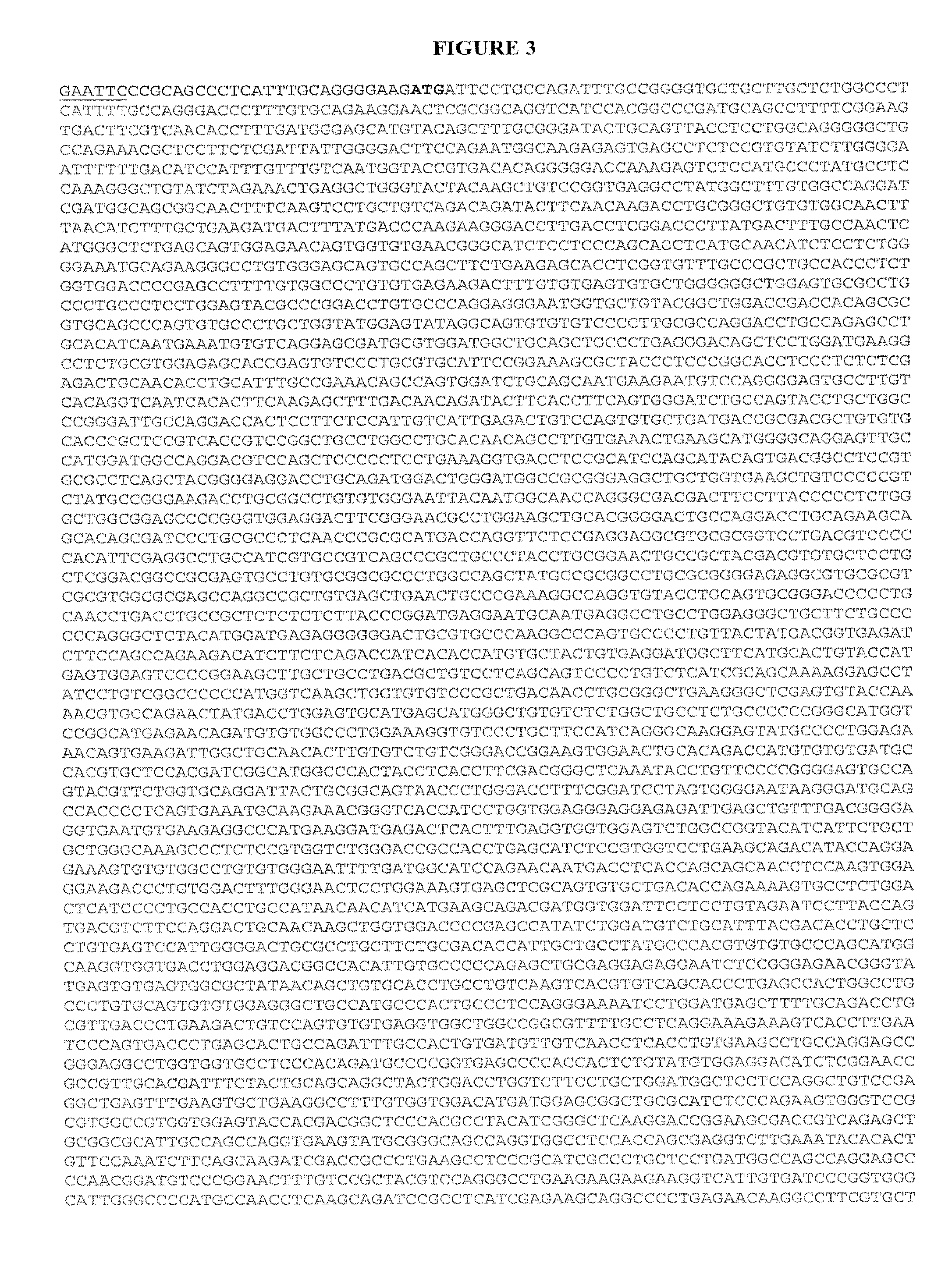Transgenic Non-Human Animals Expressing Human Blood Clotting Factors and Uses Thereof
a technology of transgenic nonhuman animals, which is applied in the field of transgenic nonhuman animals expressing human blood clotting factor, can solve the problems of increased blood coagulation tendency, inability to clot, and vwf directly interfering with blood coagulation
- Summary
- Abstract
- Description
- Claims
- Application Information
AI Technical Summary
Problems solved by technology
Method used
Image
Examples
example 1
Human Factor VIII Knock-In Transgenic Mice
[0162]In order to study the in vivo effects of inhibitors of Factor VIII (FVIII) on FVIII activity, mice which express human FVIII [Genbank Accession Nos. NM—000132 (isoform a precursor), NM—019863 (isoform b precursor)] in place of the murine gene were developed.
[0163]For FVIII knock-in mice, a plasmid containing a full-length cDNA of human FVIII was created using the pBlue-FVIII vector (#307, FIG. 1A). FVIII cDNA (7.2 kB) was cut from pBlue-FVIII #307 plasmid via Xho1 / Not1 restriction enzymes denatured and the FVIII insert purified using a gene extraction kit (Qiagen, Valencia, Calif.) using the manufacturers protocol. The FVIII insert was then inserted into either a pCMV-Sport6 vector (Gibco BRL) (FIG. 1) or a liver specific expression vector pBS-Alb / aFeto (Kellendonk et al., Genesis 126:151-53, 2000).
[0164]For cloning into the pCMV-Sport6 vector, the vector was cut with restriction enzymes Sal1 / Not1, dephosphorylated using APEX™ (heat li...
example 2
Human vWF Knock-In Transgenic Animals
[0168]Von Willebrand Factor (vWF) [Genbank Accession No. NM—000552] is required for the normal adhesion of platelets to the subendothelium for primary hemostasis, and is involved in stabilizing Factor VIII. vWF is synthesized in endothelial cells as pre-pro-vWF and processed intracellularly to propeptide and mature vWF. vWF disease is a common inherited bleeding disorder having a large number of subtypes that share a common characteristic, all involve a defect in pro-vWF. A mouse model for vWF disease has been generated using a knock-out strategy (Denis et al., Proc Natl Acad Sci. USA 95:9524-29, 1998), which mimics severe human vWF disease (type III). Injection of recombinant human vWF in vwf in knock-out mice stabilizes FVIII suggesting the human protein can function normally in murine host. In order to generate an animal model tolerant to the human vWF protein that allows for the evaluation of vWF compounds for administration to human patients...
example 3
Human Factor VII Knock-In Transgenic Animals
[0183]Factor VII [Genbank Accession Nos. NM—000131 (isoform a precursor), NM—019616 (isoform b precursor)] is a significant molecule in the clotting cascade and defects in factor VII result in bleeding disorders and reduced ability to stimulate the coagulation pathway (Osterud B., Blood Coagul Fibrinolysis 1:175-81, 1990). Congenial defects in FVII have been treated with plasma-derived and recombinant EVII (Bauer K., Haemostasis 26 Suppl 1:155-8, 1996).
[0184]To create a humanized transgenic mouse expressing the human Factor VII gene, a pB4-EVII vector containing the factor VII cDNA was digested by EcoRI to extract the cDNA. The FVII cDNA was ligated into a pBS-Alb / αFeto vector containing the albumin specific promoter. The pBS-Alb / αFeto vector was first prepared by XhoI restriction digest and then dephosphorylated using calf intestinal phosphatase (CIP) treatment. After Klenow treatment, the FVII cDNA was ligated into the pBS-Alb / αFeto vect...
PUM
| Property | Measurement | Unit |
|---|---|---|
| molecular mass | aaaaa | aaaaa |
| molecular weight | aaaaa | aaaaa |
| average molecular weight | aaaaa | aaaaa |
Abstract
Description
Claims
Application Information
 Login to View More
Login to View More - R&D
- Intellectual Property
- Life Sciences
- Materials
- Tech Scout
- Unparalleled Data Quality
- Higher Quality Content
- 60% Fewer Hallucinations
Browse by: Latest US Patents, China's latest patents, Technical Efficacy Thesaurus, Application Domain, Technology Topic, Popular Technical Reports.
© 2025 PatSnap. All rights reserved.Legal|Privacy policy|Modern Slavery Act Transparency Statement|Sitemap|About US| Contact US: help@patsnap.com



